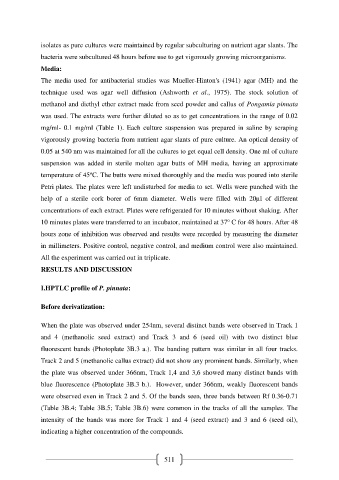Page 521 - e-Book
P. 521
isolates as pure cultures were maintained by regular subculturing on nutrient agar slants. The
bacteria were subcultured 48 hours before use to get vigorously growing microorganisms.
Media:
The media used for antibacterial studies was Mueller-Hinton's (1941) agar (MH) and the
technique used was agar well diffusion (Ashworth et al., 1975). The stock solution of
methanol and diethyl ether extract made from seed powder and callus of Pongamia pinnata
was used. The extracts were further diluted so as to get concentrations in the range of 0.02
mg/ml- 0.1 mg/ml (Table 1). Each culture suspension was prepared in saline by scraping
vigorously growing bacteria from nutrient agar slants of pure culture. An optical density of
0.05 at 540 nm was maintained for all the cultures to get equal cell density. One ml of culture
suspension was added in sterile molten agar butts of MH media, having an approximate
o
temperature of 45 C. The butts were mixed thoroughly and the media was poured into sterile
Petri plates. The plates were left undisturbed for media to set. Wells were punched with the
help of a sterile cork borer of 6mm diameter. Wells were filled with 20µl of different
concentrations of each extract. Plates were refrigerated for 10 minutes without shaking. After
o
10 minutes plates were transferred to an incubator, maintained at 37 C for 48 hours. After 48
hours zone of inhibition was observed and results were recorded by measuring the diameter
in millimeters. Positive control, negative control, and medium control were also maintained.
All the experiment was carried out in triplicate.
RESULTS AND DISCUSSION
I.HPTLC profile of P. pinnata:
Before derivatization:
When the plate was observed under 254nm, several distinct bands were observed in Track 1
and 4 (methanolic seed extract) and Track 3 and 6 (seed oil) with two distinct blue
fluorescent bands (Photoplate 3B.3 a.). The banding pattern was similar in all four tracks.
Track 2 and 5 (methanolic callus extract) did not show any prominent bands. Similarly, when
the plate was observed under 366nm, Track 1,4 and 3,6 showed many distinct bands with
blue fluorescence (Photoplate 3B.3 b.). However, under 366nm, weakly fluorescent bands
were observed even in Track 2 and 5. Of the bands seen, three bands between Rf 0.36-0.71
(Table 3B.4; Table 3B.5; Table 3B.6) were common in the tracks of all the samples. The
intensity of the bands was more for Track 1 and 4 (seed extract) and 3 and 6 (seed oil),
indicating a higher concentration of the compounds.
511

